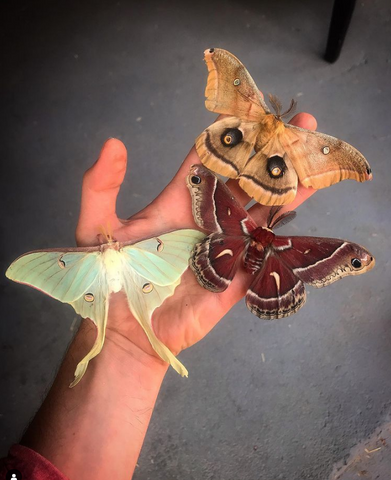Thank you to fellow Alabama gal Stephanie Lamphere, an amateur forager and lifelong learner and explorer for writing this blog for us!!! Have an idea for a blog? Write to me at howdy@sipseywilder.com with your thoughts!
Like most kids in Alabama, I grew up picking blackberries and honeysuckles by the side of the road in the summer. There was always something so satisfying about food found in nature, and it always seemed so much sweeter when I gathered it myself. Too many times I ate more blackberries than I brought home, fingers and lips stained purple from eating them directly off the vines.
All that time, I never ate wild mushrooms, nor knew anyone who did. In fact, I have always been cautioned not to! Mushrooms came from the grocery store. I have always loved mushrooms, though: sauteed, grilled, on a kabob, stuffed, in a quiche. In the last several years, I have started buying different varieties at local international markets. I had only seen one variety at the grocery store before–the regular button mushrooms, baby bellas, and portobellos (which are actually all the same species: Agaricus bisporus). In the Asian grocery, however, I started to see additional varieties: shiitake, enoki, oyster, wood ear, and king oyster. I was intrigued to find such variety.

My Sipsey Wilder Ranger pouch stuffed full of mushrooms and maypops (an edible native fruit) last fall.
During the early days of the pandemic, a miniature farmer’s market popped up in a nearby neighborhood, in which there were often foraged wild garlic and mushrooms from north Alabama. I had always had a great interest in nature and survivalism, and I suppose both my frugality and curiosity got the best of me, because soon I had joined the local mushroom foraging group on Facebook, and started hunting. I needed a new hobby anyway, and more exercise!
I spent days hiking and exploring local woods and lowlands looking for any sign of mushrooms. I inspected stumps, kicked around leaves, looked way up in trees. I stuffed my hip pouch with samples, took pictures, asked questions, did endless Google searches about mushroom features and how to tell the difference between two that are very similar. I found all sorts of mushrooms, but had no idea what I was looking at most of the time.
Tens of thousands of mushroom species have been documented around the world, hundreds of which exist in the Southeast United States. Of those, a dozen or more are known to be edible and delicious, right here in my home area. But it is not always easy to find or identify them! I have taken this as a challenge.
One thing that does make it a little bit easier is that many mushrooms appear seasonally. Watching the mushroom society’s Facebook group, I watched the seasons come and go – first, in early spring, everyone was finding morels (or wishing they could – these are near impossible to find south of Birmingham), then suddenly everyone was finding chanterelles, then chickens of the woods, hens of the woods, indigo milkcaps, wood blewits, russulas, lion’s mane, oysters, wood ears, and so many more. I was fascinated. I have tried to find them all, but they are elusive–and often more difficult is the identification!
Harvested Chanterelles (Cantherellus species) - choice edible
Lion’s mane (Hericium erinaceus) - choice edible
Mushroom identification is far more complex than plant identification, and learning how to identify them can be humbling. Just when you think you know something, you discover there is so much more to learn! Instead of just looking at leaf patterns with plants, subtle features of the mushroom’s cap, gills, stalk, attachment, what they’re growing in or on need to be carefully inspected. Sometimes even a cross-section of the insides or additional tests like spore prints must be used to differentiate similar species. In the local mushroom group on Facebook, experts ask for different views and look for these very particular features which are often too similar for the untrained eye to distinguish. It is extremely important for a newbie mushroom forager to get this assistance with identification, too, because some very tasty mushrooms look nearly identical to deadly ones… or at least mushrooms that can make you sick.
Oyster mushrooms (Pleurotus ostreatus) - edible and delicious
A deadly Amanita species (Amanita bisporigera) - a great reason to be very careful!
Deadly look-alikes are what usually keep most of us from even considering foraging for mushrooms. We are comfortable with the safety and surety of our grocery store mushrooms. I was too! But there are some wild mushrooms that are more easily identifiable than others or have no toxic look-alikes, so they’re safer for new mushroom hunters. Still, finding experts you can trust, and learning to verify distinguishing attributes is key.
Turkey tail (Trametes versicolor) - medicinal
One of many “false turkey tails” (likely Trametes betulina)
The first few times I ate a new mushroom I found in the woods I kept second guessing myself. Ultimately I had gotten multiple expert opinions and double-checked them with other resource materials, so I took the chance: I sauteed them in butter and tossed them with pasta. I am so glad I did! Now I have a hobby that gets me outdoors, makes me move, satisfies my curiosity, and… occasionally, it feeds me!
(Disclaimer: I am still very new at this, not an expert, and you should always get expert advice on edible wild findings!)
Parasol mushroom (Macrolepiota species) - edible with a toxic look-alike that is nicknamed “the vomiter”
Stump puffballs (Apioperdon pyriforme)
*All pictures credited to Stephanie Lamphere.






























